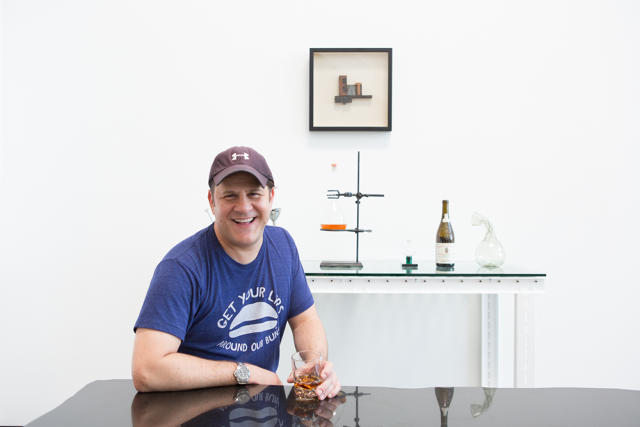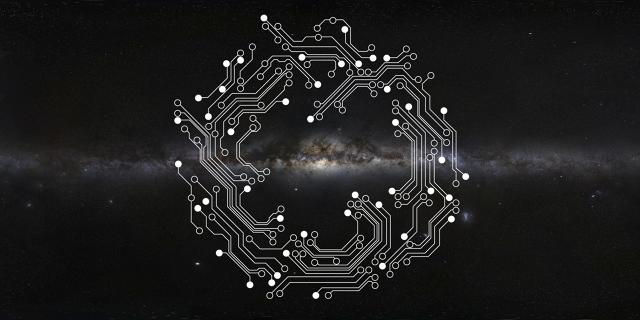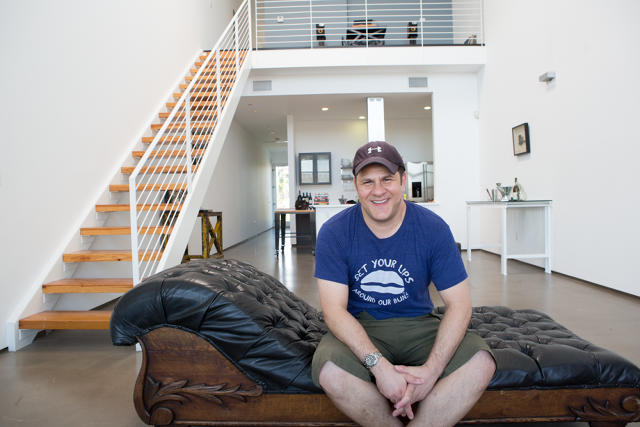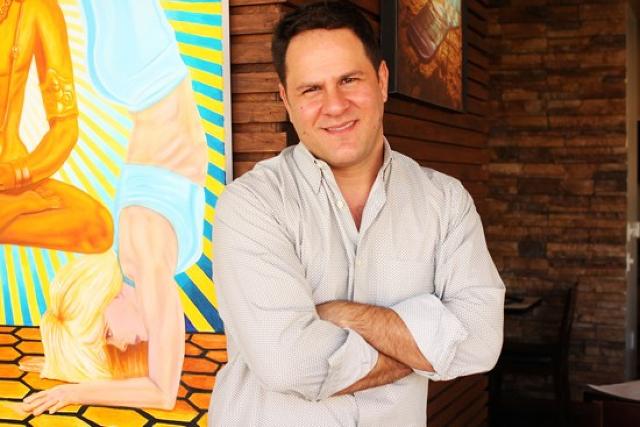The Founder Of Umami Burger Explains (Sort Of) His Baffling New Project: “Negate A For A, Negate D For D; Affirm A For D, Affirm D For A”
Adam Fleischman’s new project is a physics-based system for succeeding in business. We found it . . . confusing, so we asked him to explain.
 Adam Fleischman—a member of last year’s Fast Company MCP 100 list—launched what became a restaurant empire that he estimates now generates $80 million in sales. In 2009 he founded the Umami Restaurant Group, which has since grown to 25 restaurants in five states, with plans for more globally. Last year, after stepping down as CEO (but remaining chairman and a minority stakeholder), he founded culinary venture group AdVantage Restaurant Partners, which has another nine existing restaurants and more concepts in development.
Adam Fleischman—a member of last year’s Fast Company MCP 100 list—launched what became a restaurant empire that he estimates now generates $80 million in sales. In 2009 he founded the Umami Restaurant Group, which has since grown to 25 restaurants in five states, with plans for more globally. Last year, after stepping down as CEO (but remaining chairman and a minority stakeholder), he founded culinary venture group AdVantage Restaurant Partners, which has another nine existing restaurants and more concepts in development.
Now Fleischman is putting forth his great passion project—a concept and formulas that he’s developed over 30 years that he plans to expand into books, apps, speaking engagements, and an executive coaching business. It articulates what he maintains is a fail-safe universal precept for success in any endeavor—from business to relationships. He calls it continuum physics, and he’s outlined it in this free (for now) e-book.
We gave it a read. We were utterly flummoxed. So we asked him to clarify.

FC: What is continuum physics?
Continuum physics is the study of continuums that make up our reality. The underlying assumption is that our reality is made up of these time and space continuums rather than material things.
FC: So we’re sitting here as two people, plus the accumulation of our experiences, as filtered through our own realities?
Not just our own realities, but through other people’s realities, too. You and I are sitting here materially, but we’re also . . . experiencing physical continuums that are not just subjective, but in existence out there in the world. And those structure our fate and success with our businesses.
FC: How have you applied this concept to business?
The science posits that people only have two actions they can take in life: negation and affirmation. Affirmation is when you believe in something, like your business. Negation is when you’re skeptical, critical of, detached from, or don’t believe in it. Those are the only two real actions we can take in the world. I’ve studied thousands of successful and unsuccessful businesses. When I looked at all these businesses relative to these formulas, people were negating where they should have been affirming, and affirming where they should have been negating. They were basically pushing the wrong buttons. And the formula reads: Negate for like, affirm for opposite. So if you want something to happen the way you want it to happen, you have to negate it. If you affirm it, the opposite will happen.
FC: How is that different from looking at a situation objectively, playing devil’s advocate, or troubleshooting possible holes in your concept?
That is a symptom of this, which is a bigger thing. The continuum is looking at your actual willing, actual volition. You can play devil’s advocate all you want and still affirm. This is sampling your actual feelings about it. And people are very dishonest about what their actual feelings are. Affirmation and negation are purely intentional.

FC: How did you apply this approach to your career?
When you start a business, it’s a simultaneous process of engagement and disengagement. I’d had some failures, and when I applied them to this, I realized it was a result of too much affirmation on my part—you’re so in love with your concept that can’t step away and see it as a result, which would require negation.
Before Umami, I was working in the wine business and negating my ideas, which were certain wine bars. Within three months of working in my first wine store, an investor came in and said we should open our own wine store and kind of recruited me. I felt like, by negating my own career dreams, it was offered back to me as a singularity, which I affirmed.
When I decided to go into the restaurant business, I decided to manage that business from the perspective of those physics. I was completely engaged. I’d come up with a menu and brand that I thought had a global potential, was forward-looking and modern, and incorporated advancements in cooking. That was an affirmation of the concept. But the disengagement came with the application of it to the outside world. I’d never worked in a restaurant before. I had to be very humble and learn restaurant practices—how to run a restaurant business and organize a team—which negated my concept. When you’re doing something in time, the continuum understands that you’re negating space—which is the concept. So when you’re engaged in time, you’re actually negating the concept.
FC: How is that different from paying your dues?
It’s not that different. Reality, as you’ve experienced it and used in your entire life, is based on this physical reality. But what isn’t intuitive is this formula, because people think affirmation breeds success, work hard in this and that. If I sat down with someone who’s creating a business and ascertained whether they’re negating where they’re supposed to negate, and affirming where they’re supposed to affirm, you can ensure the success of their business from the outset, rather than having them keep making mistakes.

FC: Can you elaborate on the “Pull of the Dual” concept?
The push and pull of the dual, the engagement and disengagement, the negation and the affirmation, these are all the same. That’s subjective. But the objective world isn’t about the dual. It’s about the single—it’s the product. The product contains the dual, but you don’t know that going into it, because you only get their encapsulated time once you get into their continuum through the experience of using the product.
The continuum physics nature is trying to get us to accept a singularity when we push on these two dual elements. So if I’m engaged and disengaged in everything that I do, by pushing on the dual, I’m jamming the system. The system doesn’t want you to engage and disengage, and have your will on both sides of the equation. So what they do is offer you a new singularity, which is what we call fate or an event. So you get offered a new chance, a new job, your restaurant is successful—that’s the singularity. You’re given a singularity that you’ve created, paradoxically, through a dual process. That’s where the user has to make the choice. Do we accept that singularity and affirm it, or go back to the duality?
So, when I started Umami Burger, I was engaged by leasing the space, hiring a chef, creating a menu. But I was also disengaged from the outcome, meaning, it’ll either work or it won’t. That duality jammed the fate system that said you can’t be going in two directions with volition at once. So it offers a singularity as an outcome, which becomes your brand.
FC: Do you affirm or negate that singularity?
If you affirm it, you’re engaged in your business, but you’re not going to move it forward. That can be okay, if you plan on starting other restaurants, like I did. I affirmed, because I wanted it to be its own entity and live in the world on its own. It has its own CEO and board, and I’m a very small piece of it.
If you’re pushing on the dual, fate is always going to offer you a singularity that wants to trick you into affirming or negating it. It wants a single answer. If you refuse to make that decision, it will go away. You can be in such a state of limbo that your business can fail.

FC: You mention actual formulas that apply to these concepts?
Step 1 is the fate formula: Negate A for A, negate D for D; Affirm A for D, affirm D for A
A is the identity of the concept and eternals that are inherent, and D is the temporal, time, reality. So when you’re negating the concept, you’re simultaneously affirming the temporal. D for A is your belief that your concept could exist in reality.
So “negate A for A” means to achieve recognition of your concept, such as your business. You ultimately have to negate the import of that concept. So you have to come out of the theoretical world of concepts and into the real world, which is D, the temporal world, the world we live in. We share clock time. So we have to negate the concept for its success, and negate your time for your success in time.
The A and D characters create a duality of a time-and-space world. Only negating is like throwing the baby out with the bathwater. You can imagine people who are so negating that they never do anything at all. The continuum wants the pull of the dual. Affirm-negate all the time. So when I came up with my idea for my restaurant, I affirmed it, but then instantly negated it.
Step 2 is the value creation formula: D in A is affirmed to A value, then D in A negated becomes D power of the brand
This builds on the fate formula by incorporating the outside world. The fate formula is for you, the subject. The value creation formula is more for the business. You’re looking at it more through the outside world.
These formulas give you a way, mathematically, to complete, more algorithmically, the amount of reality versus the amount of ideation in a concept to make sure that balance is there. I want to create an algorithm in the programming world—an applied use of continuum physics—so that it can be used in computers to track these types of things.
FC: What would you use for data points to plug into the algorithm?
The actions of the people doing the creating. They would put in their data points and come up with an outcome of whether it’s going to work or not. I think it would be useful if people could answer 10 questions and know whether their business was going to succeed or not.

FC: You refer to a product as not just providing a service, but containing within it, the experience it brings to the user. How is that different than branding?
Everything in the temporal world is experiential but hasn’t been quantified until this science. It’s only been qualified through the concept itself.
Through experience you’re creating the value of these brands. But the real trick is not looking at the experience as a theoretical, conceptual thing, but seeing it as an actual physical continuum out there in the world that exists. That’s the real crazy part of this. I’m saying, it’s actually physical. It isn’t just theoretical, or the accumulation of experiences.
They’re perceivable through the end user’s experience. As consumers, we think we’re buying a thing. If I buy a bottle of wine that’s $10, I’m buying something. If it’s $10,000, I’m buying something better. Reality—vis-à-vis, continuum physics—is not that simple. The physics says that the reason one bottle is $10 and another is $10,000 is because it isn’t entirely based on what the wine’s made of. In fact, they’re actually of equal value, in terms of what they’re actually made of—grape juice and glass. What you’re not getting is the experience—these continuums—that are actual pieces of time and experience associated in reality with these products.

FC: How do you put that experience in your product?
For a product to be successful, the experience of the user has to be in the product. You can’t just create a product in five minutes and have it work, it has to be something that’s created over a long period of time or done by a person with decades of experience. If I’m going to open a winery tomorrow that sells $10,000 bottles of wine, it’s never going to happen. This only happens over a period of time, learning, and experience.
FC: What about beginner’s luck, people who hit it big early?
What we’re talking about here is short-term value creation, i.e the one-hit wonder. That person can be seen as a negation over time, because they’re not actually doing anything. So when you first do something, that first affirmation is a negation of the reality. That creates an artificial affirmation in the short term, but it’s not sustainable. So you’re negating the prior existence for something that starts right then. But you’re not thinking in terms of long-term value creation, so you affirm it right away. “I got this one hit. I’m on my way. I’m 22 years old. I’m going to be famous forever.” What reality has done has just responded to your initial affirmation of something that you’re putting out there. The first step is being affirmed. But it’s not affirming anything else beyond the first step. And if you want long-term value creation, you have to think of it that way and say, “Hey, that was a first step, that was pretty good, sold a million records, I’m going to do it again.” That’s a negational attitude. That’s what Bob Marley and The Beatles did, and that’s why they had 30-year careers, because it was a completely different attitude than the short-term value creation.
FC: A Justin Beiber or Kanye West are people who seem to have bought into their own success, and are affirming constantly. But they are successful.
Yes, these are people who buy into their own myth every day. They’re not defying the system, they’re young and their career arc over their entire lifetime ends up being balanced in the affirmation/negation over the period of time. They’re in a short-time schema now, where they’re affirming, but once it flips over, and they’ve put out these continuums, there’s no way for them to go back and alter what they are, and they could have a long, long period of decline after the initial success, that, in retrospect, at the end of their life, you’ll think of them as more in terms of a failure than as a success. I’m not saying these particular people will. They still have the option of free will, affirming or negating their own careers. And for all we know, they may not have bought into their own myth, but put that out there as part of their characters. If they’re putting out a persona that’s the biggest ego on earth, but secretly, they don’t believe in that, then they’re negating. It just depends on their intent versus reality.

FC: What about someone who does everything right and still doesn’t achieve success?
They haven’t done everything correctly. They just think they have. The physics doesn’t allow for ambiguity in this. You can hear their story and in five minutes identify the data points that were done right and wrong.
Their own volition may have changed at some point. That’s the number one thing why things fail. People didn’t care anymore; they wanted to do something else. Once their volition changes, that’s a negation in itself. While that could help it, they’re not doing the affirmation, the engagement-disengagement part we talked about.

FC: How do you see expanding this into a business?
The book is free for now, but eventually, it will be a subscription-based model, with other books and possibly videos added to the site. I would like to consult for businesses to show them where they line up in these types of formulations and their ultimate chances of success or failure based on the data points of what they’re doing.
The coaching can help people craft conceptual elements of their business plans, but it would be better when they’re past the business-planning stage and have launched it. But as they’re starting, people can use this by asking questions of themselves, whether they’re affirming or reflecting the power and pull of the dual.
[Burger Concept: Ilya Akinshin via Shutterstock]
Fast Company , Read Full Story
(271)














